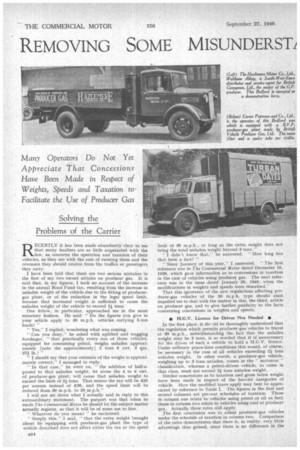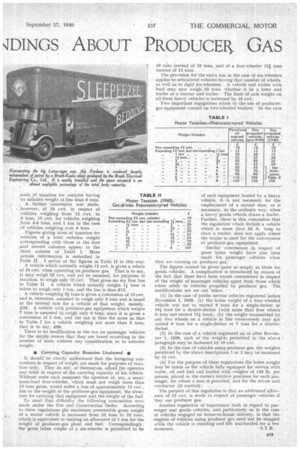REMOVING SOME MISUNDERST) ■ IDINGS ABOUT PRODUCER GAS
Page 32

Page 33

If you've noticed an error in this article please click here to report it so we can fix it.
Many Operators Do Not Yet Appreciate That Concessions Have Been Made in Respect of Weights, Speeds and Taxation toFacilitate the Use of Producer Gas
Solving the Problems of the Carrier
RECENTLY it has been made abundantly clear to me that many hauliers are as little acquainted with the law, as concerns the operation and taxation of their vehicles, as they are with the cost of running them and the revenues they should receive from the traffics or passengers they carry.
I have been told that there are two serious mistakes in the first of my two recent articles on producer gas. It is said that, in my figures. I took no account of the increase in the annual Road Fund tax, resulting from the increase in unladen weight of the vehicle due to the fitting of producergas plant, or of the reduction in the legal speed limit, because that increased weight is sufficient to cause the unladen weight of the vehicle to exceed 2i tons.
One fellow, in particular, approached me in the most minatory fashion. He said: " Do the figures you give in your article apply to 30 m.p.h. vehicles carrying 5-ton loads?
" Yes," I replied, wondering what was coming.
" Can you deny," he asked with uplifted and wagging forefinger, " that practically every one of those vehicles, equipped for consuming petrol, weighs unladen approximately [note the approximately] 2 tons 9 cwt, 3 qrs.
• 271 113.? " .
" I should say that your estimate of the weight is approximately correct," I managed to reply.
" In that case," he went on, "the addition of half-apound to that unladen weight, let alone the 4 to 6 cwt. of producer-gas plant, will cause that unladen weight to exceed the limit of 2i• tons. That means the tax will be £35 per 'annum instead of £30, and the speed limit will be reduced from 30 m.p.h. to 20 m.p.h."
I will not set down what I actually said in reply to this extraordinary statement. The purport was that when he reads The Commercial Motor he should let the subject matter actually register, so that it will be of some use to him.
" Whatever do you mean? " he exclaimed.
" Simply this," I said, " that the extra weight brought about by equipping with producer-gas plant the type of vehicle described does not affect either the tax or the speed B14 limit of 30 m.p.h., so long as the extra weight does not bring the total unladen weight beyond 3 tons." " I didn't know that," he answered. "How long has that been a fact? "
" Since January of this year," I answered. " The first reference was in The Commercial Motor dated December 16, 1939, which gave information as to concessions in taxation in the case of vehicles using producer gas. The next reference was in the issue .dated January 20, 1940, when the modifications in weights and speeds were described."
That this ignorance of the new regulations affecting producer-gas vehicles of the 30 m.p.h. type should exist impelled me to deal with the matter in this, the third, article on producer gas, and to give further publicity to the facts concerning concessions in weights and speeds.
• H.G.V. Licence for Driver Not Needed • In the first place, it sheald be thoroughly understood that the regulation which permits producer-gas vehicles to travel at 30 m.p.h., notwithstanding the fact that the unladen weight may be 3 tons, is so worded that it is unnecessary for the driver of such a vehicle to hold a H.G.V. licence. Under ordinary peace-time conditions this would, of course, be necessary in the case of all vehicles exceeding 21 tons unladen weight. In other words, a producer-gas vehicle, weighing up to 3 tons unladen, comes in the " motorcar" classification, whereas a petrol-driven vehicle, to come in that class, must not exceed 2i• tons unladen weight.
Similar concessions as to taxation and gross laden weight have been made in respect of the heavier Categories of vehicle. How the modified taxes apply may best be appreciated by reference to Table I. The figures in the first and second columns are pre-war schedules of taxation. Those in column one relate to vehicles using petrol or oil as fuel; those in column two relate to vehicles using coal or producer gas. Actually those rates still apply. The first concession was to admit producer-gas vehicles under the schedule of taxation in column two. Comparison of the rates demonstrates that there is, in reality, very little advantage thus gained, since there is no difference in the • scale of taxation for vehicles having an unladen weight of less than 6 tons. . A further concession was made, . however, of 10 cwt. in respect of vehicles weighing from 12 cwt. to 3 tons, 15 cwt. for vehicles weighing from 3-6 tons, and 1 ton in the case of vehicles weighing over 6 tons.
Figures giving rates of taxation for vehicles of a, total unladen weight corresponding with those in the first $and second columns appear in the third column of Table I. More precige information is embodied in Table IL I arrive at the figures in Table II in this way. A vehicle which normally weighs 12 cwt, is given a rebate of 10 cwt. when operating on producer gas. That is to say, it may weigh 22 cwt. and yet be assumed, for purposes of taxation, to weigh only 12 cwt. That gives me my first line in Table II. A vehicle which actually weighs 11 tons is taken to weigh only 1 ton, and the tax is thus £15.
A vehicle weighing 3/ tons is given a concession of 15 cwt. and is, therefore, assumed to weigh only 3 tons and is taxed at the normal rate for a vehicle of that weight, namely, £35. A vehicle with producer-gas equipment which weighs 7 tons is assumed to_weigh only 6 tons, since it is given a concession of 1 ton, and the tax is thus the same as that in Table I for a vehicle weighing not more than 6 tons, that is to say, £90.
There is no modification in the tax on passenger vehicles for the simple reason that they are taxed according to the number of seats without any consideration as to unladen weight.
• Carrying Capacity Remains Unaltered • • . It should be clearly understood that the foregoing concessions in respect of weight are made for purposes of taxation only. They do not, of themselves, afford the operator any relief in respect of the carrying capacity of his vehicle. Without some such easement the operator of, say, a maximum-load four-wheeler, which must not weigh more than 12 tons gross, would suffer a loss of approximately 15 cwt., due to the weight of the producer-gas equipment, the structure for carrying that equipment and the weight of the fuel.
To meet that difficulty the following concessions were made under the Use and Construction Order. According to these regulations he maximum permissible gross weight of a motor vehicle is increased from 22 tons to 23 tons, which is equivalent to making an allowance of 1 ton for the weight of producer-gas plant and fuel. Correspondingly, the gross laden weight of a six-wheeler is permitted to be 20 tons instead of 19 tons, and of a four-wheeler 12/ tons instead Of 12 tons.
The provision for the extra ton in the case of six-wheelers applies to articulated vehicles having that number of wheels, as well as to rigid six-wheelers. A vehicle and trailer with load may now weigh 23 tons, whether it be a lorry and trailer or a tractor and trailer. The limit of axle weight on all these heavy vehicles is increased by 15 cwt.
Two important regulations relate to the use of producergas equipment carried on two-wheeled trailers. In the case
of such equipment hauled by a heavy vehicle, it is not necessary for the employment of a second man, as is necessary, in the ordinary way, when a heavy goods vehicle draws a trailer. Further, there-is this concession that the regulation which forbids a vehicle which is more than 26 ft. long to draw a trailer, does not apply where the trailer is used for the conveyance of producer-gas equipment.
Similar concessions in respect of gross laden weight have also been made foe passenger vehicles when they are running on producer gas.
The figures cannot be given quite so simply as those for goods vehicles. A complication is introduced by reason of the fact that there have been recent concessions in respect of the weight of passenger vehicles apart from those which relate solely to vehicles propelled by producer gas. The modifications are set out below.
(1) In the case of public service vehicles registered before November 1, 1939, (a) the laden weight of a four-wheeled vehicle was not to exceed 9 ,tons for a single-decker or 10/tons for a double-decker (with more than four wheels it may not exceed in tons); (b) the weight transmitted by any two wheels on a vehicle in line transversely ma' tot exceed 6 tons for a single-decker or 7 tons for a doubledecker.
(2) In the case of a vehicle registered on or after Novem ber 1, 1939, each of the weights permitted in the above . .
„, 105
paragraph may be increased by 10 civt.
(3) In the case of vehicles using producer gas, the weights permitted by the above descriptions 1 or 2 may be increased by 15 cwt, (4) For the purpose of these regulations the laden weight may be taken as the vehicle fully equipped for service with water, oil and fuel and loaded with weights of 140 lb. per person, placed in the correct relative positions for each passenger, for whom a seat is provided, and for the driver and conductor (if carried).
The purport of this regulation is that an additional allowance of 15 cwt. is made in respect of passenger vehicles if they use producer gas.
Another regulation of importance both in regard to passenger and goods vehicles, and particularly so in the case of vehicles engaged on house-to-house delivery, is that the engines of vehicles using producer gas need not be stopped while the vehicle is standing and left unattended for a few moments. • S.T.R.




















































